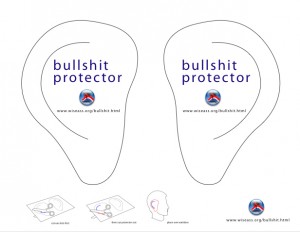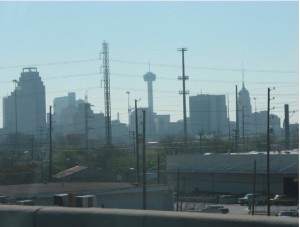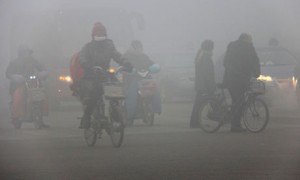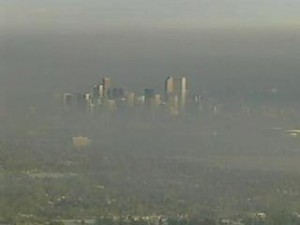Ozone
Happy DFW Non-Attainment Day!
 It came a little later than usual this year, but the final dog days of August finally churned out the inevitable DFW Non-Attainment Day on Saturday. And nature was just cheeky enough to wait until right before the state's open house on yet another clean air plan for the area.
It came a little later than usual this year, but the final dog days of August finally churned out the inevitable DFW Non-Attainment Day on Saturday. And nature was just cheeky enough to wait until right before the state's open house on yet another clean air plan for the area.
Non-Attainment Day is the (so far) annual day when one lucky regional air monitor registers its fourth "exceedence" of the old 85 parts per billion smog standard left over from the 1990's, signaling an official violation of the federal Clean Air Act and meaning that DFW is still mired in high levels of ozone.
On Saturday it was the Denton Airport monitor that saw an 8-hour average of 85 ppb, one that matched Friday's result as well. Together, the two readings combined with another 85 ppb from August 20th and a 90 ppb level from early July to produce four readings of 85 ppb or more by the end of the month. That makes it official. It's the 17th year in a row that DFW hasn't met the old smog standard.
Although it's bad news that we're once again in violation of an obsolete smog standard, this summer's cooler weather and rain has kept smog down to levels not seen since 2007. If Denton is the only monitor to record an official violation of the 85 standard, that will be the fewest number doing so since 2007 as well, when there were two. Last year there were five and the year before that, six.
But as of 2015, the region will need to get ozone levels down to no more than the new EPA-approved level of 75 ppb if it wants safe and legal air. A plan to help the region do that is supposed to be drafted by the Texas Commission on Environmental Quality, although no one knows exactly when that process will start.
As it happens however, the TCE is hosting a "public information meeting" on such a new air plan at the public-friendly hour of 10 am this coming Thursday at the North Texas Council of Governments headquarters in Arlington at 616 Six Flags Road. Don't expect any explanations for what that is, because there aren't any. However, it is most assuredly not a meeting of the local North Texas Clean Air Steering Committee, the advisory group charged with assisting the TCEQ in putting together a clean air plan. That would require more concern for clean air than the state can muster right now, with a deadline still a whole 16 months away.
With the summer trending well up to now, we suspect the TCEQ crew thought they could come up to DFW from Austin without having to use the dreadful N-word to describe DFW's condition. Now, not so much. It's an embarrassment too. If the region can't reach attainment when the weather is on your side, what's it going to be like when real a Texas Summer returns? 2013 was absolutely the best shot we had at finally seeing the numbers drop significantly. And now that's been blown.
Of course, if the last state clean air plan had worked the way Austin told us it would, we wouldn't even be writing this blog post because DFW would have reached attainment status last year. But the plan didn't exactly work the way Austin said it would. in fact, it made air quality measurably worse.
What Wednesday’s Vote Means for Dallas, the Shale, and the Rest of the Universe
 Wednesday's vote on the Trinity East permits was not only an historic one. It's a long overdue turning point.
Wednesday's vote on the Trinity East permits was not only an historic one. It's a long overdue turning point.
The bloody knuckle political fight over urban gas drilling in Dallas in 2013 is the fight local environmentalists owed Fort Worth in 2006. Our collective failure in Cowtown gave the gas industry a too-friendly template for every other DFW city that's come after Fort Worth's gas rush.
Wednesday that template got tossed. A clearly frustrated Trinity East lobbyist complained that the company wouldn't even have had to participate in a Council hearing like this one if the same permits were being sought in Fort Worth. Welcome to Big D.
We can't undo old wrongs, but we can start changing the pattern of behavior that keeps churning out new ones. Wednesday's vote by the Dallas City Council was, by far, the highest-profile rebuke of the gas industry in a region it thinks its owns lock, stock and barrel. As he Dallas Morning News put it, "the defeat could be the death knell for natural gas drilling in a city known around the world for its ties to the petroleum industry." Politically, we aren't in Fort Worth anymore.
So what else is new after yesterday? From micro to macro:
From just a basic civics perspective, it's hard not to be impressed with the job that residents did in mobilizing themselves into a persistent and contentious force for change. This wasn't just an environmental victory. It was a victory for grassroots organizing. Residents had to fight not only the gas industry, but Dallas City Hall staff and the Mayor, who were all doing their best to rig the process in Trinity East's favor. Moreover, they had to fight on multiple fronts at the same time, both within the regulatory process to deny the permits outright, and in the Spring's city council elections to make sure they had the votes once the permits got to the horseshoe on Marilla. And oh yeah, they've had to put together and lobby for the toughest regulations to be included in a new ordinance being written, also at the same time.
That said, the last nine months have seen the biggest show of green political muscle in the city's history. If you total up the numbers of people involved, throw in a scandalous secret memo that brings down a City Manager, add triumphs in half the council elections you enter, and pile on winning-over the local conservative daily newspaper, then there's just no comparison. The momentum carried into Wednesday's meeting when opponents got two more votes than the four that were needed to block the permits, for a total of six. That's a far cry from the two or three everyone was sure about when this started last winter. We've seen the Dallas environmental movement grow up right before our eyes into something nobody, including environmentalists, thought it was capable of being when this started.
The fruit of this new growth was on display at City Hall (Coverge from the DMN, KERA, CultureMap and the Observer). There's no precedent for the kind of coalition that turned-out, except maybe the anti-Trinity Tollroad coalition that almost upended the Citizens Council's plans for solar-powered water taxis and riverside freeways in the 1990's. There were West Dallas residents from La Bajada, Oak Cliff dwellers, North and East Dallas homeowners association presidents, Students, teachers, professionals, gas lease owners, environmentalists, neighborhood activists, an Irving city council member, young mothers, young grandmothers and everything in between. Reflecting this diversity was a Council coalition that included both Hispanic Council members, Adam Medrano and Monica Alonzo, African-American Carolyn Davis, newcomer Philip Kingston, and stalwarts Sandy Greyson and Scott Griggs. If this alliance of interests holds together, it stands a very good chance of getting a strong new ordinance in the coming months.
And what about that new ordinance? With the old business of Trinity East now concluded, all attention is directed at Dallas writing and passing the most protective gas drilling ordinance in the Barnett Shale by the end of the year. The chances of that happening went up dramatically with Wednesday's vote.
One of the most unexpected results coming out of the confrontation was Mayor Rawlings' seemingly blunt declaration that he was four-square against urban drilling in Dallas. Saying the city could afford to be picky about the kind of development it seeks, he stated he didn't think gas drilling was a good match for Dallas and looked forward to passing a strong new ordinance. We'll see. Actions speak louder than words, and so far the Mayor's actions on this issue have all been in service to approving the Trinity East permits. With that fight resolved, can he be trusted to embrace a new philosophy? We'll be able to tell soon enough with a draft ordinance due to be delivered by the Plan Commission to the Council in late September. At any rate, his public confession on Wednesday is another sign of how far the Dallas movement has come. It's impossible to imagine Fort Worth Mayor Betsy Price uttering the same words.
It also gives the new members of the City Council some cover to vote for tougher regulations as well. Rumor has it that Jennifer Staubach-Gates was agonizing over the Trinity East vote even as she entered the Council Chambers. She eventually voted with the Mayor but as an ex- school nurse who's dealt with asthmatic kids firsthand, she's concerned about air pollution and other public health consequences of fracking. The Mayor's coming out against drilling in Dallas may embolden her and others to get on the band wagon. Rawlings' statement also sets a high bar for the slew of Mayoral candidates coming up in the next election cycle.
Residents now must focus on the last two Plan Commission meetings and hearings that are deciding what kind of new gas drilling ordinance Dallas will write. And they represent very full plates of issues indeed:
On Thursday, September 12th, at 8:30 am the Commission will begin work on the topics of "Air Quality," "Water," "Pipelines" and "Compressor Stations" in their morning workshop. At 1:30 pm that same day they'll get around to holding another one of their unique (anti-public) public hearings at City Hall on those same subjects. It's vital that residents remain plugged into this process and show up to speak on these incredibly important issues.
Just as opponents all got behind the idea of 1,500 foot setbacks and made it a mantra, we no need to coalesce around three or four central and simple concepts for the 12th including: 1) Air Pollution Off-sets, 2) Special Zoning Districts for Compressors, and 3) much higher water rates for taking water permanently out of the hydrological cycle.
– Off-sets would require that gas operators estimate how much new greenhouse gas (GHG) pollution they'll emit into the air every year based on EPA numbers and their own self-reporting, and then off-set those increases in air pollution by paying for pre-approved air pollution control projects in Dallas that would reduce pollution. If you expect to release 5 tons of emissions from your gas operations, you will have to pay for reducing five tons of air pollution in the city by electrifying a car fleet, improving energy efficiency measures in homes and buildings, putting more bikes on the street and so forth. In this way, off-sets also act as a strong incentive to decrease emissions as much as possible at the sources themselves. The less you pollute i nthe first place, the less you have to pay to off-set that pollution.
Unlike every other heavy industry that does business in a smog "non-attainment" area such as DFW, the gas industry is exempt from having to do this at the federal level. So we want Dallas to be the first city in the nation to fix that loophole by requiring local off-sets. This would be a precedent-setting piece of policy-making that citizens could then take to other Barnett Shale cities and counties. A grassroots regional policy could grow out of the Dallas template – much like it did when Dallas passed the first "green cement" procurement policy in 2007. That campaign lead to the eventual closing of all seven old wet kilns in Midlothian and millions of pounds of air pollution permanently eliminated. It forced the cement industry to clean up. We want to do the same thing with the gas industry and offsets.
This new policy could be the beginning of a tool that we can use to significantly reduce gas industry air pollution, not only in DFW, but in smoggy metro areas throughout the U.S. that now also host gas drilling, like Denver, Pittsburgh, and Los Angeles.
– Compressor Stations are the big league polluters of the natural gas fuel cycle, running 24/7 365 days a year and emitting voluminous amounts of air pollution. Some compressor stations release more Volatile Organic Compounds than the Midlothian cement plants and they're huge greenhouse gas polluters. A recent study from the Houston Advanced Research Center found that a single flare or compressor could raise downwind smog levels by 3-5 parts per billion or more within five miles. Compressors should be required to get their own Special Zoning District with strict rules on sound, pollution and setbacks.
– Water is precious in NorthTexas and industries that take it permanently out of the hydrological cycle should pay more than those that don't. A lot more, because it means we have to go out and find that water anew. Likewise, during drought conditions, water should be for drinking, not fracking. It's critical we make the industry pay for the real costs of using so much of this absolutely necessary resource and then throwing it away for good down a hole.
On Thursday September 26th the Plan Commission will hold its final public hearing on the new gas ordinance. Then it will vote on a draft to send the City Council. Again, citizens need a good turnout for sending this document off, whether it has everything in it we want, or it's lacking in some important way. We need to be there.
We are only these two September hearings away from showing up at the Dallas City Council with the most protective gas drilling ordinance in the Barnett Shale and providing the region and the country a new alternative for the obsolete Fort Worth model.
If you came down to City Hall, if you e-mailed, or phoned or wrote – Thank you for your contribution to the fight. It took exactly the amount of effort you and everyone else gave to make Wednesday's victory happen. It will take it again to pass a great ordinance.
But stick with us. We're making history.
State Ignores Latest Failure and Local Air Committee, Will Host “Public Information Meeting” on DFW Smog
 This curt announcement went out last Friday courtesy of the Texas Commission on Environmental Quality:
This curt announcement went out last Friday courtesy of the Texas Commission on Environmental Quality:
The Texas Commission on Environmental Quality (TCEQ) will host a public information meeting to provide information on the development of revisions to the SIP for the 2008 ozone National Ambient Air Quality Standard (NAAQS) in the 10-county Dallas-Fort Worth (DFW) nonattainment area. The meeting will take place on Thursday, September 5, 2013 at 10:00 a.m. at the North Central Texas Council of Governments (NCTCOG), Transportation Council Room, 616 Six Flags Drive, Arlington, Texas 76005. NCTCOG and United States Environmental Protection Agency (EPA) representatives will also provide updates on local and federal initiatives.
What this doesn't say is that the last local clean air plan drafted by Rick Perry's TCEQ failed miserably last summer when DFW actually ended up with worse air than when it had begun in 2010. The state can't even bring itself to admit that. It's never had a successful smog plan in DFW, but only Rick Perry's TCEQ plan actually made the air worse. Maybe that's why they're holding this "public information meeting" at a mid-morning time guaranteed to result in a low rate of participation by actual DFW citizens.
You'd also never guess from this release that DFW has a local advisory board for drafting its own clean air plans. The North Texas Clean Air Steering Committee was constituted specifically for the purposes of working with the state on such plans. It hasn't met in two years. Nor is it likely to meet anytime soon if Rick Perry's TCEQ has its way – the state considers it a nuisance to have to come up here and explain itself to local elected officials and environmentalists.
Did we say environmentalists? Since the 2006-2007 smog plan, citizen groups have held three seats on the Committee to balance out the three seats given the local Chambers of Commerce. Right now those seats are held by Downwiders at Risk, the Sierra Club/Public Citizen and the Environmental Defense Fund. The rest of the slots are filled by local city council members, Mayors, County Commissioners and County Judges.
Downwinder's own Jim Schermbeck is a member and has used the meetings of the Committee to cross-examine Rick Perry's TCEQ officials who otherwise receive a mostly unquestioning welcome everywhere else they go. Committee meetings are the one place that representatives fo citizens groups can ask questions like a legislator in an Austin hearing. And the TCEQ reallly doesn't like that. Especially when we've been right about so many things and the TCEQ so wrong.
It's also true that Rick Perry's TCEQ really doesn't even bother to start any kind of consultation or planning process in DFW until a year before the plan is due. Since a new plan to achieve the new ozons/smog standard of 75 parts per billion doesn't kick in until 2015, it's doubtful the Committee will be called to order before next Spring. That way the pollution control measures needed by any plan have no chance of passing a state legislature at the last moment in 2015, ensuing that no real changes take place and DFW remains smoggy.
Perhaps you think that's way too cynical a perspective. But that's exactly what happened this last cycle in 2010-2011. And it was actually worse, because the biggest part of that last plan was to sit back and watch as DFW residents bought new cars. No moving parts.
Meanwhile, can anyone name a current local elected official who's known for their advocacy of clean air? Dallas Mayor Laura Miller fought Perry's coal plants in 2006. in 2013, her successor, Dallas Mayor Mike Rawlings protects secret deals with gas drillers. Dr./Mayor Cluck in Arlington has voted in favor for dozens, if not hundreds, of gas wells near homes, parks, and day care centers even as he recites his familiar litany about running into childhood asthma victims in the hospital emergency room. Fort Worth? Bought and sold to Chesapeake. Dallas County? They're too busy indiscriminately dropping pesticides on us. Mayor Evans of Plano used to be a voice of reason in Collin County. Now you've got Judge Keith Self who never met an air polluter he didn't liked.
Some stalwarts like Parker County Judge Mark Riley and Tarrant County Judge Glenn Whitley still represent moderate Republican views, but many of their peers have been replaced by Tea Party members who think smog is as imaginary a problem as climate change. We're actually going backwards in our local political engagement of the issue.
If TCEQ is emasculating the local advisory group on clean air, it's certainly getting a valuable assist from a feckless DFW indigenous officialdom, who seemed to have all walked away as a group from clean air as a goal they were willing to strive to achieve.
So mark your calendars for another citizen-friendly TCEQ "public information meeting"….at 10 am on a Thursday morning, September 5th, in Arlginton at North Texas Council of Government headquarters, when most people will be working and unable to attend. For for the sensitive among you, we suggest also attending with some handy BS protectors for your ears so as not to irrevokably damage logic receptors in the brain.
Ozone Season Update: July Goes Out Like A Lamb; August Comes In Like a Lion
 After an uncharacteristically mild June and July produced the best ozone season in six or seven years, August arrived to remind us what summer in Texas is supposed to be about.
After an uncharacteristically mild June and July produced the best ozone season in six or seven years, August arrived to remind us what summer in Texas is supposed to be about.
Seven of 20 smog monitors saw their annual highs set last Thursday, August 1st, when temperatures begin to climb back to the triple digits, with the one at Arlington's Municipal Airport recording a regional 2013 high of 93 parts per billion.
Perhaps more worrisome is the fact that on the same day, the Dallas Hinton Street site by Mockingbird and Interstate 35 also set its annual high of of 87 ppm. That's the first time this season that a monitoring site so far east in the heart of the DFW central corridor has gone above the magical 85 ppb level. And it's at a site that had not been a problem for ozone until the last couple of years. The fact that it's still capable of reverting back to these kinds of readings despite the weather-driven reprieve this year is a bad sign.
DFW hasn't yet achieved compliance with the 85 ppb standard for smog left over from 1997, and must meet a newer, tougher standard of 75 ppb by the end of the summer in 2018.
To date, four DFW monitors have had an "exceedence" of the old 85 ppb standard this year – Hinton, Arlington, Denton Airport, and Pilot Point. It takes four such exceedences to produce an official Clean Air Act "violation" that counts against the region's goal of "attainment" with the standard. So, four strikes and you're out.
By this time last year, we'd already achieved that level of non-compliance. As of now, we're still three bad air days away from that milestone.
On the other hand, all but two DFW ozone monitors have had one or more exceedence of the 75 ppb one, and in fact four have already had four or more of them – Fort Worth Northwest, Keller, Denton Airport and…Hinton Street. That's how tough the new standard is. Even after a two month head start of rain and cooler weather, DFW is already violating it at four monitors.
This week's forecast is calling for Texas-like August heat. If the wind drops below 10 mph, we should see smog levels rise again. Traditionally, August and September are among DFW's worst bad air months. Whether 2013 will be the first year to see no official violations of the old 85 ppb standard will depend on whether the next two months are as kind to us as the last two.
TCEQ: Eagle Ford Gas Pollution Making San Antonio Smog Worse
 According to a new study from the Texas Commission on Environmental Quality and the Alamo Area Council of Governments, air pollution from the Eagle Ford gas play in South Texas will increase smog levels in San Antonio by 3 to 7 parts ber billion by 2018, the year the nation's metro areas are supposed to be in compliance with a new tougher federal standard.
According to a new study from the Texas Commission on Environmental Quality and the Alamo Area Council of Governments, air pollution from the Eagle Ford gas play in South Texas will increase smog levels in San Antonio by 3 to 7 parts ber billion by 2018, the year the nation's metro areas are supposed to be in compliance with a new tougher federal standard.
Because San Antonio's air is already in violation of federal standards, a rise in ozone levels of even 1 ppb matters. San Antonio's ozone average is at 80 ppb and the federal standard is at 75 ppb.
Since it relied on TCEQ engineers and TCEQ computer models, one can safely assume this study is underestimating the problem of this pollution.
On the otheFrom the beginning of the fracking boom, it's been the contention of Rick Perry's TCEQ that gas industry pollution from the Barnett Shale has no significant effect on DFW smog. "All the wells are west of central DFW" goes the rationale, even as Dallas debates new drilling and refinery permits. A lot of us, including atmospheric scientists who study this sort of thing, beleive differently.
For two years in a row, air quality in DFW has gotten worse, not better, They've been more violations and they've moved further east. While 2013 has the potential to be the best year for smog in DFW this decade, it may have much more to do with the cooler, wetter weather than any large decreases in pollution inventories. However, given the impacts outlined
Study: 2 Million Air Pollution Deaths Annually Worldwide, 77,000 in US
 We're a bit behind the curve in reporting on this, but scientists at the University of North Carolina just published a study in "Environmetnal Research Letters" that estimates Particulate Matter and Ozone pollution in the air is responsible for approximately 2.2 million deaths worldwide every year.
We're a bit behind the curve in reporting on this, but scientists at the University of North Carolina just published a study in "Environmetnal Research Letters" that estimates Particulate Matter and Ozone pollution in the air is responsible for approximately 2.2 million deaths worldwide every year.
Long-timers already know about how insidious Particulate Matter can be, but this only chronicles the hardcore fatal respiratory and cardiovascular impacts, concluding the tiny particles of soot cause at least 2.1 million deaths every year while ozone pollution shortens another 500,000 lives.
"East Asia," aka China, accounts for fully have of both those figures. India for another third. In North America, the casualties include 43,000 premature deaths from PM pollution and 33,000 from ozone.
Jason West, co-author of the study said: "Outdoor air pollution is an important problem and among the most important environmental risk factors for health."
Although alarming, these numbers are all underestimates of the health impacts of both of these pollutants, since they exclude anything other than fatalities. Besides making it harder to breathe, PM pollution has been linked to brain disorders and immune system disruptions.
Colorado: Oil and Gas Now the Main Source of Smog-Forming VOCs and Third Largest Source of Nitrogen Oxides
 At least 600 tons of air pollution a day caused by the oil and gas industry in Colorado is causing a lot of consternation, especially in the Denver Metro area, which, like DFW, is currently out of compliance with the Clean Air Act for ozone, or smog.
At least 600 tons of air pollution a day caused by the oil and gas industry in Colorado is causing a lot of consternation, especially in the Denver Metro area, which, like DFW, is currently out of compliance with the Clean Air Act for ozone, or smog.
Oil and gas emissions now are the main source of volatile organic compounds in Colorado and the third-largest source of nitrogen oxides, at a time when a nine-county area around metro Denver is already failing to meet federal clean-air standards, state data show.
New Studies Link Air Pollution to Cancer, Heart Failure and…Appendicitis?
 According to CBS News
According to CBS News
"A new study published July 10 in The Lancet showed that even breathing low levels of air pollution for a prolonged period of time could raise risk for the often-deadly lung disease. Another study released on the same date showed that short-term exposure to most major air pollutants could increase the risks of hospitalization and death from heart failure."
Lung cancer risks went up 18% with each increase of 5 migrograms of PM 2.5. Researchers noted that they did not find a level of pollution for where there was no risk, and the results indicated "the more the worse, the less the better" when it came to pollution.
"At this stage, we might have to add air pollution, even at current concentrations, to the list of causes of lung cancer and recognize that air pollution has large effects on public health," Takashi Yorifuji from the Okayama University Graduate School of Environmental and Life Science and Saori Kashima from Hiroshima University in Japan…."
A second study shows the risk of dying or going to the hospital because of heart failure increased by 3.52 percent for every 1 part per million increase of carbon monoxide levels; 2.36 percent for every increase of 10 parts per billion of sulfur dioxide; 1.7 percent for ever 10 parts per billion increase in nitrogen dioxide; and about 2 percent for every 10 micrograms per cubic meter increase of particulate matter. Surprisingly, increases in ozone were not linked to heart failure. Unsurprisingly, you're breahting in all of these kinds of air pollution if you live in DFW.
All of that is kind of old news – put stuff in air, see stuff harm your lungs and heart. But here's a new "adverse health effect" being linked to air pollution – appendicitis. While not as lethal as lung cancers and heart attacks, anyone who's had their appendix rupture can tell you it's not a pleasant experience.
And while ozone may not have been linked to heart problems in that previous study, the New York Times reports a Canadian one links it to a slight increase in your chances of having appendicitis.
High ozone levels were associated with an increased number of hospitalizations for appendicitis and were even more strongly associated with cases of burst appendix. For each 16 parts per billion increase in ozone concentration the scientists found an 11 to 22 percent increase in ruptured appendix cases. The study was published in Environmental Health Perspectives. The associations persisted after controlling for age, sex, season of the year and the presence of other air pollutants, like nitrogen dioxide and particulate matter. The reason for the association is unclear, but studies in mice have shown that air pollution can alter the animals’ abdominal bacteria.
Who knew?
Take Another Hit – It Was the Best June for DFW Breathing Since 2007
 If this unseasonable cooler weather is making it seem like you're spending summer someplace other than DFW, it's also been the best "ozone season" in the region in seven years.
If this unseasonable cooler weather is making it seem like you're spending summer someplace other than DFW, it's also been the best "ozone season" in the region in seven years.
In the month that just ended, we only had four monitors on four days that violated the new 75 parts per billion smog standard that takes effect in 2018, and zero violations of the obsolete 1997 85 ppb standard. The maximum 8-hour reading was an 83 at the Denton Airport on June 3rd. Contrast that with last June: 54 violations of the 75 ppb standard and 27 violations of the 85 ppb standard over 9 days. Or 2011 – 24 violations of the 75 ppb standard, 7 violations of the 85 standard.
In fact, you have to go back all the way to 2007 when we had five violations of the 75 ppb standard but no "exceedences" of the 85 ppb, to find as good a June for air quality as we just had. And there are only a couple of other Junes – in 2010 and 2000 that even come close to being as full of safe and legal air. That's the good news.
The bad news is that these years were all followed by worsening air quality trends, that is, they turned out to be aberrations. So if this pattern holds, we'll have to wait until next summer to put it in context. As always, weather has a lot to do with how bad or good our ozone season is. The cooler and wetter, the better. The dryer and hotter, the worse. Just as this summer's cooler temps seem like they're out of place, by next June we could be thinking the same thing about our reprieve from smog.
The good news is that there's no questions that declining emissions in almost every category (we're looking at you oil and gas) have had a positive impact on the numbers. That's your doing. After 20 years of citizen effort, there's a lot less pollution from the cement plant complex in Midlothian, the coal plant belt in East Texas, and the millions of vehicles on and off the road.
For the EPA and the state, 2013 comes a year too late to help them recover from a terrible 2011 "clean air plan" that was supposed to get us down below 85 ppb by watching people purchase new cars. The clock officially ran out on that plan June 15th. Sales of new vehicles are dramatically up, so there's real displacement as old gas guzzlers get traded in for more efficient models. Whether those trade-ins are enough to cancel out the still-exploding growth rate of the area and rising gas and oil activity remains to be seen. That's why the EPA uses a three-year rolling average to determine transgressions against the Clean Air Act, to minimize the impact of anomalies.
You're just going to have to stay tuned to find out whether the summer of 2013 is the exception to the rule, or the re-writing of the rules.
Notice Something Missing So Far This Summer? Smog Alerts.
 Along with cooler weather in general and a little more rain this Spring has come some relief from really dirty air in DFW.
Along with cooler weather in general and a little more rain this Spring has come some relief from really dirty air in DFW.
Last year at this time, we'd already had 6 "exceedences" of the old 1997 85 parts per billion ozone standard in May, and countless exceedences of the tougher new 75 ppb standard that is supposed to be attained by 2018. As of today, we haven't had one even one monitor reading above 85 ppb and only a handful in the 75 to 85 ppb range.
For the last two years in a row, DFW has seen a decrease in air quality, and an increase in smog. Could 2013 be the year that trend is halted?
Weather takes a lot, or even most of the credit. Cooler temperatures and more moisture are not conducive to ozone creation. But unlike during the recession, new car sales seem to be taking off the way the Rick Perry-approved engineers at the Texas Commission on Environmental Quality wanted them to two to three years ago. It's possible that the replacement of older dirtier vehicles with newer, cleaner ones by the thousands has finally made a difference you can't see. There's also the impact of cleaner operations at the Midlothian cement plants thanks to citizen victories over the last decade, (although the kilns are rapidly turning back into garbage burners), fewer coal burning plants downwind, and other improvements up and down the southeast to northwest axis that carries our predominant winds from Houston to here.
On the other hand, last June was pretty quiet until the 24th, and then all hell broke loose, with ozone levels into the triple digits. 2012 turned out to be a very bad year for safe and legal air.
And there's the unknowns that nobody's really examining closely – at least not in public. How much ozone pollution is being caused by the natural gas infrastructure in the Barnett Shale that's been built over the last decade and gets bigger every week? How much is the gas industry polluting upwind of us in places like Freestone County between here and Houston? Does the continuing boomtown growth in DFW population cancel out the improvement in individual vehicle emissions?
From a regulatory point of view, no matter how good or bad this summer is, we don't get credit for it either way. Another bad year wouldn't be held against us. Likewise, no violations this entire year wouldn't buy us any more goodwill from EPA. We're in a limbo period, where everyone is just waiting around for the average readings from 2015 -2018 to accumulate and tell us what category of compliance with the new 75 ppb standard we're in. While it would certainly help the cause if the region had some forward momentum in lowering the levels of smog going into 2015, officially, it makes no difference at all – unless you're breathing air. Then, according to EPA's own scientists, anything above 65-70 ppb is damaging to human health.
Theoretically, the TCEQ is supposed to be putting together yet another "DFW clean air plan" to reach that 75ppb standard, to be implemented sometime between now and 2015. The last time it tried to reach such a regulatory goal – the 85 ppb standard – it ended up with a plan that worsened air quality here by starting way too late and basically doing nothing but watching as new cars were going to clean up the air in the middle of a recession. (By the way, the "official" regulatory date of that failure is coming up next week even though the failure was certain last summer. Stay tuned to see if TCEQ acknowledges it in any way).
It's the summer of 2013. Any big changes that need to be in a summer of 2015 clean air plan should be being discussed and set in motion now, especially if they need 2015 state legislative approval, or lead times for industry to adapt. However, state or regional officials have yet to call a meeting of the local advisory group that's supposed to be monitoring the development of that plan. No date is set for such a meeting.
We can hope that a confluence of circumstances is making it possible to have cleaner air in DFW, but as long as Rick Perry is Governor, it's unlikely such an important public health goal will override political agendas.
